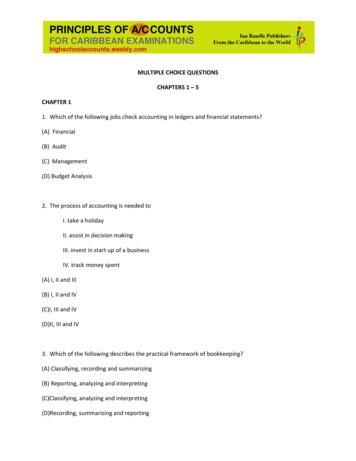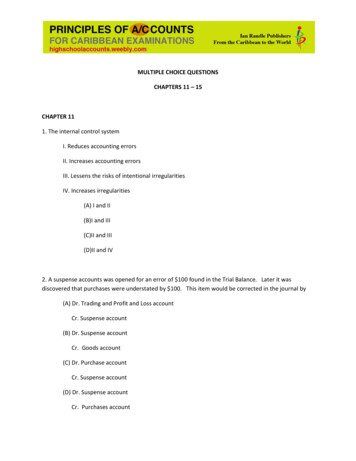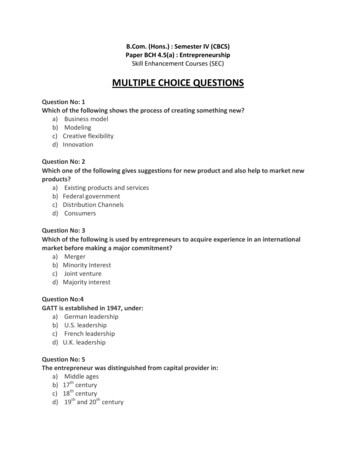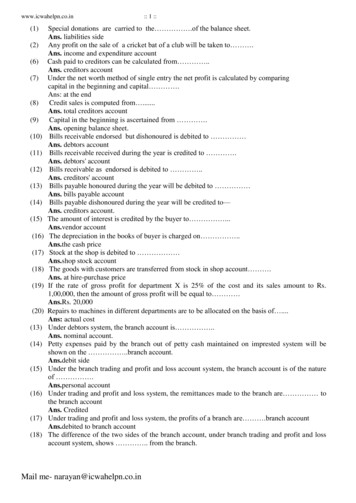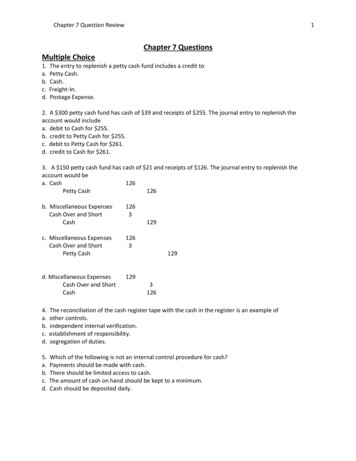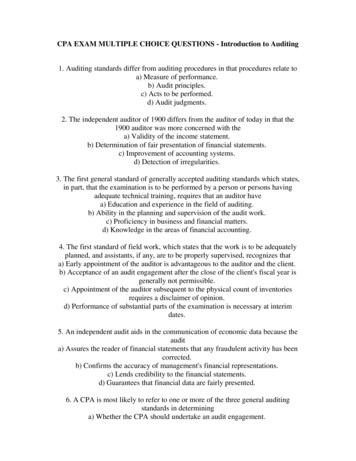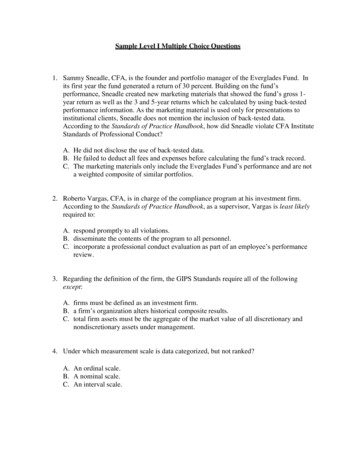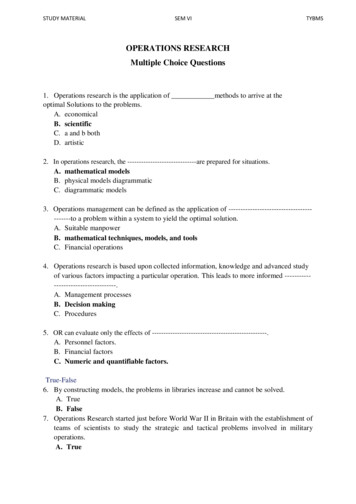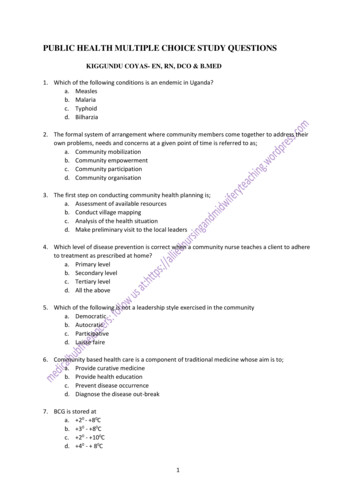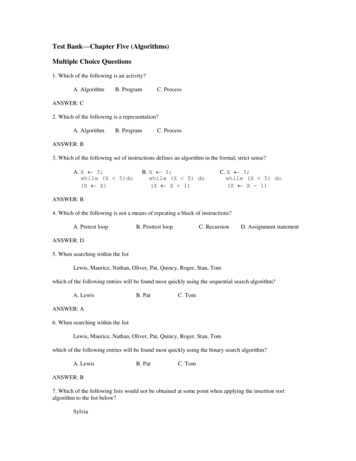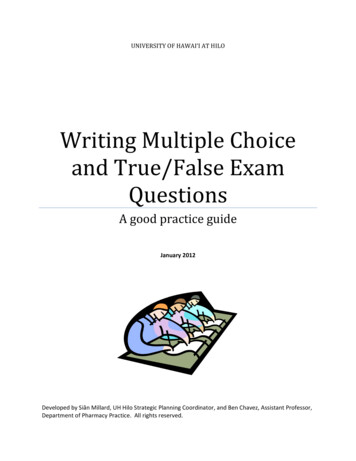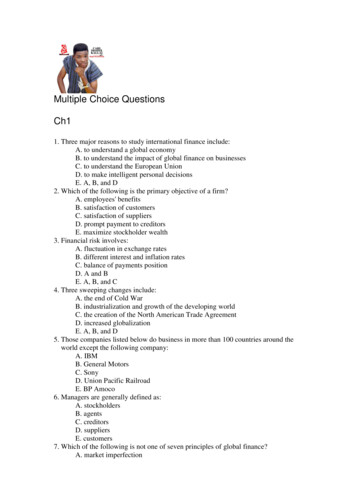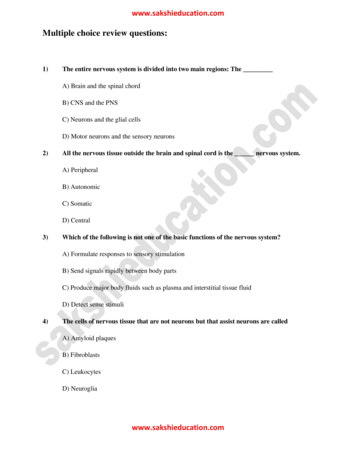
Transcription
www.sakshieducation.comMultiple choice review questions:1)The entire nervous system is divided into two main regions: TheA) Brain and the spinal chordB) CNS and the PNSC) Neurons and the glial cellsD) Motor neurons and the sensory neurons2)All the nervous tissue outside the brain and spinal cord is the nervous system.A) PeripheralB) AutonomicC) SomaticD) Central3)Which of the following is not one of the basic functions of the nervous system?A) Formulate responses to sensory stimulationB) Send signals rapidly between body partsC) Produce major body fluids such as plasma and interstitial tissue fluidD) Detect sense stimuli4)The cells of nervous tissue that are not neurons but that assist neurons are calledA) Amyloid plaquesB) FibroblastsC) LeukocytesD) Neurogliawww.sakshieducation.com
www.sakshieducation.com5)The white fatty substance that coats axons to increase signal speed isA) MyelinB) MicrofibrilsC) DendritesD) Adipocytes6)One example of a function of neuroglial cells is to A) Add myelin to axonsB) Produce neurotransmittersC) Bind neurotransmittersD) Link one neuron cell to another at the synapse7)neuron transmits signals from the PNS to the central nervous system.A) InterneuronB) SensoryC) MotorD) Ganglion8)An involuntary response by the nervous system to a stimulus is aA) SynapseB) ReflexC) Motor responseD) Smooth muscle9)The axon has voltage gated ion channels. The term "voltage gated" means that A) Ion channels open and close because of changes in the neuron’s voltageB) Neuron voltage is controlled by neuroglial cellsC) Iongates will not respond unless the neuron is in the CNSD) Voltage can only be controlled by a reflexwww.sakshieducation.com
www.sakshieducation.com10)Both the depolarization and repolarization changes that occur during the action potentialare produced byA) Ions moving across the cell membraneB) Small neuroglial cells that act as batteries for the neuron itselfC) Negative stimuliD) Enzymes creating new ions11)The movement of K out of the cell makes the inside of the cell less positive (morenegative) and acts to restore the original resting voltage of the neuron -a process calledA) DepolarizationB) HyperpolarizationC) RepolarizationD) Overshoot12)Arrange these action potential events in their proper sequence:(1) The neuron is stimulated at the dendrites(2) K gates open(3) The neuron is in a polarized “resting” state(4) Na gates open(5) The cell is fully depolarized(6) The cell is fully repolarizedA) 1, 2, 4, 3, 5, 6B) 3, 1, 4, 5, 2, 6C) 4, 6, 2, 1, 5, 3D) 1, 4, 2, 6, 5, 3www.sakshieducation.com
www.sakshieducation.com13)When the neurotransmitter molecules released from the axon terminals of a neuron havediffused across the synapse and have reached the dendrites of the target neuron, theneurotransmittersA) Enter the target neuron by membrane transport proteins (ion channels)B) Diffuse out of the synapse without causing any response in the target neuronC) Bind to receptor proteinsD) Stimulate neuron growth14)When a neurotransmitter binds to a receptor on the target cell, it causes the target cell tohave a (n) A) RepolarizationB) Growth phaseC) Growth inhibitionD) Action potential15)A bundle of axons in the PNS is called aA) Tract.B) NerveC) NucleusD) Ganglion16)The right and left halves of the cerebrum (the cerebral hemispheres) are connected toeach other mainly by a bundle of neuron axons called theA) Thalamus.B) Insula.C) Corpus cavernosum.D) Corpus callosum.www.sakshieducation.com
www.sakshieducation.com17)Which are not areas of the cerebrum?A) Sensory signal receiving areasB) Heart rate and breathing rate control areasC) Logic and language areasD) Motor signal generating areas18)Sensations from the skin are converted to perceptions in which part of the cerebrum?A) the primary motor areaB) the primary sensory areaC) Wernicke's areaD) Broca’s area19)Signals from the sense organs(such as the ears, eyes, nose, and mouth) are received andanalyzed in what part of the brain?A) The cerebellumB) The cerebrumC) The brainstemD) The diencephalon20)The area of the brain responsible for conscious thought, intellect, memory storage andprocessing, controlling the movement of skeletal muscles, and sensation is theA) thalamus.B) cerebellum.C) medulla oblongata.D) cerebrum.www.sakshieducation.com
www.sakshieducation.com21)Emotions, regulation of sleep, wakefulness, sexual arousal, thirst, hunger, bodytemperature, and production of certain hormones are all functions of what structure ofthe brain?A) HypothalamusB) ThalamusC) CerebrumD) Cerebellum22)This brain area is a routing center for incoming sense signalsA) CerebellumB) Brain stemC) ThalamusD) Spinal cord23)The hypothalamus does not contain a control center for the homeostatic regulation ofA) Body temperature.B) Various emotional states.C) UrinationD) Eating.24)The region of the CNS that contains the vital centers for regulating breathing rate, heartrate, and blood pressure is theA) Thalamus.B) Cerebrum.C) Medulla oblongata.D) Cerebellum.www.sakshieducation.com
www.sakshieducation.com25)Damage to the cerebellum causesA) Uncontrollable hungerB) Coma.C) Loss of speechD) Loss of balance26)The spinal cord contains tracts of inter neurons. Some tracts carry signalsdownward and other tracts carry signals upward.A) Cardiac, MotorB) Sensory, AutonomicC) Sensory, MotorD) Motor, Sensory27)The PNS contains these types of neurons (two answers)A) SensoryB) Inter neuronsC) Motor neuronsD) Neuroglial neurons28)Somatic motor neurons have axons that conduct signals from the CNS to ; and areusually under control.A) Skeletal muscle; involuntaryB) Hollow organs; voluntaryC) Hollow organs; involuntaryD) Skeletal muscle; voluntarywww.sakshieducation.com
www.sakshieducation.com29)Involuntary muscles and glands are innervated (stimulated by) neurons of thenervous systemA) autonomicB) somaticC) sensoryD) central30)Targets of the autonomic nervous system include all of the following exceptA) cardiac muscle.B) glands.C) skeletal muscle.D) smooth muscle in hollow organs.31)The two major divisions of the ANS areA) Peripheral and Central nervous systemsB) Voluntary and involuntary musclesC) Sympathetic and parasympatheticD) Neurons and neuroglia32)Which ANS division is more active when we are relaxed and peaceful?A) ParasympatheticB) VoluntaryC) PeripheralD) Centralwww.sakshieducation.com
www.sakshieducation.com33)The "fight or flight" response is the term used to describe activation of the .A) Parasympathetic divisionB) Sympathetic divisionC) Somatic nervous systemD) CNS34)Motor signals in the ANS always pass through (a number) motor neuron(s) beforereaching a muscle. Motor signals in the SNS always pass through (a number) motorneuron(s) before reaching a muscle.A) 2, 2B) 2, 1C) 1, 3D) 1, 235)The ganglia of the division are closer to the spine than the ganglia of thedivision.A) Sympathetic, ParasympatheticB) Parasympathetic, PeripheralC) Sympathetic, PeripheralD) Parasympathetic, Sympathetic36)The effects of sympathetic and parasympathetic neurons on the heart can best bedescribed asA) antagonistic.B) identicalC) cooperative.D) adrenergicwww.sakshieducation.com
www.sakshieducation.com37)In general, parasympathetic activation will produce effects that are to thoseproduced by activation of sympathetic neurons.A) similarB) antagonisticC) complimentaryD) identical38)Which of the following releases norepinephrine as a neurotransmitter?A) preganglionic sympathetic neuronsB) postganglionic sympathetic neuronsC) preganglionic parasympathetic neuronsD) postganglionic parasympathetic neurons39)All motor neurons release acetylcholine as a neurotransmitter exceptA) Postganglionic sympathetic neuronsB) Somatic motor neuronsC) Postganglionic parasympathetic neuronsD) Specific cardiac and smooth muscle fibers.40)When the parasympathetic system is stimulated, what neurotransmitter is released?A) AcetylcholineB) NorepinephrineC) EpinephrineD) Dopaminewww.sakshieducation.com
www.sakshieducation.com41)Which of the following statements is true for preganglionic sympathetic neurons of theANS?A) They are longer than postganglionic sympathetic neurons.B) They receive signals from interneuronsC) They release norepinephrine.D) They synapse with muscles42)Sensory neurons have the shape shown below on the left. The name of this neuron shapeis . Most motor nurons and interneurons have the shape shown below on theright. The name of this neuron shape is .A) Unipolar neuron & Unipolar neuronC) Unipolar neuron & Multipolar neuronB) Multipolar neuron & Unipolar neuron D) All the above43)Sensory nerve signals converge in the , where they are sorted and relayed to theproper sensory areas of the cerebrum for interpretation.A) Pons B) Thalamus C) Medulla D) Allwww.sakshieducation.com
www.sakshieducation.com44)45)Name ventricles A and B shown below. (Hint: Ventricles names are numbers).A) 3rd & 4th ventriclesB)2nd & 4th VentriclesC) 1st & 2nd ventriclesD) 2nd & 3rd ventriclesThe dendrites of a neuron contain , which allow the neuron to bind to and respondto neurotransmittersA) MyelinB) Receptor proteins C) Na and K ions D) NoneAnswers to multiple choice questions:1 B 2 A 3 C 4 D 5 A 6 A 7 B 8 B 9 A 10 A 11 C 12 B13 C 14 D 15 B 16 D 17 B 18 B 19 B 20 D 21 A 22 C 23 C24 C 25 D 26 D 27 A and C 28 D 29 A 30 C 31 C 32 A 33 B34 B 35 A 36 A 37 B 38 B 39 A 40 A 41 C 42 C 43 B 44 A45 Bwww.sakshieducation.com
www.sakshieducation.com www.sakshieducation.com Multiple choice review questions: 1) The entire nervous system is divided into two main regions: The _
